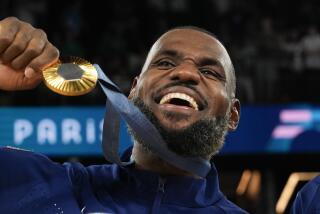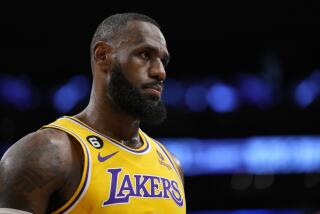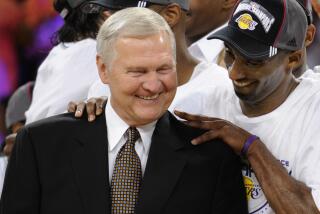Heartache of a Champion
- Share via
Laker coach Bill Sharman was surprised to see Times sportswriter Mal Florence, bags packed, leaving the team hotel in Milwaukee on a January day in 1972.
Florence had been following the team on its winning streak, which had reached a record 33 games before Kareem Abdul-Jabbar and the Milwaukee Bucks had ended it the previous day, 120-104.
“Where are you going, Mal?” Sharman asked.
“I don’t cover losers,” snapped back Florence, without breaking stride.
Funny line.
But it also reflected the perception of the day. Unlike the Minneapolis Lakers or the Showtime Lakers or the current Lakers, the team that had arrived here in 1960 carried a loser image for more than a decade.
It wasn’t that it was a dreadful team. In fact, the early Los Angeles Lakers were pretty darn good. They had two of the brightest stars in the game in Elgin Baylor and Jerry West. They had powerful forwards in Rudy LaRusso and Happy Hairston. They had a colorful coach in Fred Schaus and a colorful player in Hot Rod Hundley. And overall, they had enough talent to make regular trips to the NBA Finals.
But once there, they had to play the dreaded Boston Celtics in that chamber of horrors known as Boston Garden. Time and again, they would come out second best, stamped as chokers who couldn’t win the big one.
That was unfair. They simply couldn’t beat the big one in the middle, Boston center Bill Russell. He was only 6 feet 9, but in those days, that was enough to make him a giant on the court, an impregnable defensive force and a fierce and effective rebounder. The Lakers, trying to match up with players like Ray Felix and Jim Krebs, always came up short.
Talk about frustration! In one game, Russell blocked a shot by Felix. Then he did it again. And again and again and again. Finally, Felix hooked one that went over Russell, over the basket, over the backboard into the stands.
Felix grinned and said to Russell, “That’s one you’ll never get, baby.”
It wasn’t as if the Lakers were getting blown out of those championship series. The Lakers came close on several occasions. But that only made it more painful.
In 1962, Laker Frank Selvy had an open 15-foot jumper to win the NBA Finals in Game 7 against the Celtics at Boston Garden, but missed. Boston went on to win in overtime.
Laker announcer Chick Hearn felt that set the tone for a decade, felt that if Selvy had made that shot, the difference in confidence level and attitude between those teams might have altered all the championship series that followed.
For the 1968-69 season, the Lakers obtained center Wilt Chamberlain, until then the most dominating force, in terms of individual achievement, the league had ever known. Finally, a player to counter Russell. With three superstars, the Lakers would surely obliterate their image as perennial runners-up.
The Lakers made it back to the NBA Finals that season and found their old nemesis, the Celtics, there. Ultimately it came down to a seventh game, this time at the Forum, a game that would later be referred to in anger and depression by Laker fans as “the balloon game.”
The balloons were owner Jack Kent Cooke’s idea. He had them placed in the Forum rafters in anticipation of the celebration after his team had broken the Celtic jinx.
Russell, upon arriving the Forum, glanced up and saw the balloons, then vowed they would not come down.
And they didn’t. Late in the game, Boston’s Don Nelson fired a shot at a crucial point. It missed the mark but bounced straight up, then came down through the basket.
The Lakers lost--as usual--108-106, but they couldn’t blame it on bad luck or bad karma. Their problem was bad feelings between Chamberlain and Coach Bill van Breda Kolff. In the closing minutes, Chamberlain had asked to be taken out, claiming he was injured. When the Lakers rallied and Chamberlain asked to go back in, van Breda Kolff told him the team was doing just fine without him.
So the Lakers ended that season with Chamberlain on the bench, the balloons in the rafters and their record of futility intact.
At the start of the 1970s, the Lakers had new hope because Father Time had done what they never could: removed the Russell factor.
But there was a new tormentor on the block in New York Knick center Willis Reed.
The 1969-70 season ended with the Lakers again in the NBA Finals, this time playing the Knicks. Once again, it came down to a seventh game, this time at Madison Square Garden. Reed wasn’t supposed to play because of a leg injury. But when he limped onto the court and played the first few minutes, the emotional lift whipped the fans into a frenzy and solidified the rest of the Knicks into an unbeatable unit that crushed yet another Laker title dream.
There would always be another chance to dream, but not for Baylor. Age and injuries forced the high-flying Laker forward into retirement nine games into the 1971-72 season.
But as Baylor’s flame was snuffed out, the rest of the Lakers were suddenly ignited. Chamberlain and West were still playing at high levels, Hairston was still a master rebounder, Jim McMillian was an able replacement for Baylor at small forward and Gale Goodrich was an ideal backcourt mate for West.
The day after Baylor said goodbye, the Lakers took off on their record 33-game winning streak, the longest for a professional team in any sport. They finished the season with 69 wins, a record that stood until the Chicago Bulls broke it with 72 victories in the 1995-96 season. Goodrich averaged 25.9 points in 1971-72, West 25.8. Chamberlain and Hairston each pulled down 1,000 rebounds.
The Lakers roared through the first two rounds of the playoffs, sweeping Chicago in four games, then beating Milwaukee, the team that had stopped their streak, in six.
Ahead lay their old Waterloo, the NBA Finals, and a rematch with the Knicks. In all, the Lakers had lost seven times in the Finals after moving to Los Angeles, six of those to the Celtics.
All of their records in that unprecedented season would mean nothing if it ended as had the others.
But this Laker team was so talented, no barrier, no jinx could withstand it. The team won the championship in five games, its first since calling Los Angeles home.
This, however, was no dynasty. The Lakers returned to the NBA Finals the following season, but returned also to their losing ways, New York winning in five.
Despite all the big names on their roster, the Lakers had that elusive magic touch for only one season.
It would take seven more years until they returned to the NBA Finals, seven years until they got the Magic they needed to build a dynasty worthy of the Minneapolis days.
More to Read
All things Lakers, all the time.
Get all the Lakers news you need in Dan Woike's weekly newsletter.
You may occasionally receive promotional content from the Los Angeles Times.






